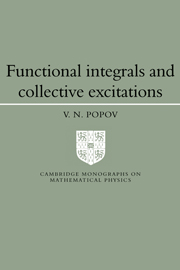Book contents
- Frontmatter
- Contents
- Preface
- Part I Functional integrals and diagram techniques in statistical physics
- Part II Superfluid Bose systems
- Part III Plasma and superfluid Fermi systems
- Part IV Crystals, heavy atoms, model Hamiltonians
- 18 Functional integral approach to the theory of crystals
- 19 Effective interaction of electrons near the Fermi surface
- 20 Crystal structure of a dense electron–ion system
- 21 Quantum crystals
- 22 The theory of heavy atoms
- 23 Functional integral approach to the theory of model Hamiltonians
- References
- Suggested further reading
- Index
23 - Functional integral approach to the theory of model Hamiltonians
Published online by Cambridge University Press: 01 June 2011
- Frontmatter
- Contents
- Preface
- Part I Functional integrals and diagram techniques in statistical physics
- Part II Superfluid Bose systems
- Part III Plasma and superfluid Fermi systems
- Part IV Crystals, heavy atoms, model Hamiltonians
- 18 Functional integral approach to the theory of crystals
- 19 Effective interaction of electrons near the Fermi surface
- 20 Crystal structure of a dense electron–ion system
- 21 Quantum crystals
- 22 The theory of heavy atoms
- 23 Functional integral approach to the theory of model Hamiltonians
- References
- Suggested further reading
- Index
Summary
In this section we outline the functional integral approach to the mathematically rigorous theory of the so-called model Hamiltonians system such as the Bardeen–Cooper–Schriffer (BCS) model in superconductivity (Bardeen, Cooper & Schriffer, 1957) or the Dicke model of superradiation. The problem of developing a rigorous theory of such models was put forward by Bogoliubov, Zubarev & Tserkovnikov (1960). This problem was solved for the BCS model by Bogoliubov (1960), who developed the so-called approximation Hamiltonian method. This method may be applied to the Dicke model as well. A rigorous theory of the Dicke model was suggested by Hepp & Lieb (1973). They have shown that there exists an exact solution of the model in the thermodynamic limit. The superradiation phase transition in this model was also described by these authors.
The approximation Hamiltonian method was applied to the Dicke model by Bogoliubov Jr (1974). Rigorous results for free energy and boson averages were obtained (see Bogoliubov Jr et al., 1981).
Functional integral methods were also applied to the Dicke model. Moshchinsky & Fedianin (1977) obtained asymptotics of Z/Z0, where Z is the partition function of the model and Z0 is the partition function of the corresponding free system. Kirianov and Yarunin (1980) investigated the Bose excitation spectrum of the system below the phase transition point in the superradiation state.
In this section we will prove the asymptotics of Z/Z0 for the Dicke model with a single mode of the radiation field (Popov & Fedotov, 1982).
- Type
- Chapter
- Information
- Functional Integrals and Collective Excitations , pp. 195 - 211Publisher: Cambridge University PressPrint publication year: 1988



